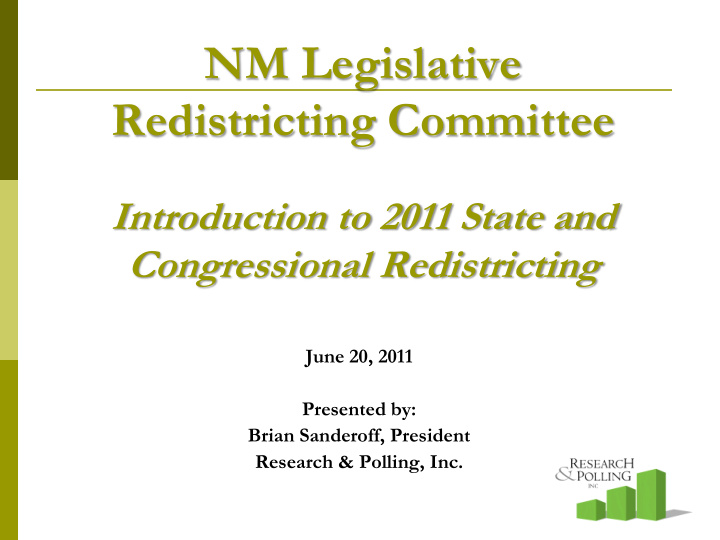



NM Legislative Redistricting Committee Introduction to 2011 State and Congressional Redistricting June 20, 2011 Presented by: Brian Sanderoff, President Research & Polling, Inc.
Principles of Redistricting Equal population Minority Voting Rights Compactness Contiguity Communities of interest Research & Polling, Inc. 3
Who Gets Counted? Everyone, including, but not limited to: Adults Children College students in dorms Prisoners Non-citizens Undocumented immigrants Foreign students Foreign workers (e.g. German Air Force personnel at Holloman AFB) Research & Polling, Inc. 4
Constitutional Mandate to Redistrict Gray v. Sanders, 1963 “One person, one vote” Equal population = equal representation Congress: as equal as possible State legislature, other entities: 10% total spread (± 5%) Research & Polling, Inc. 5
Equal Population Ideal district population = total state population / # of districts NM Congressional Districts NM’s population = 2,059,179 # of Congressional Districts =3 Ideal population of a CD = 686,393 (= 2,059,179 / 3) Research & Polling, Inc. 6
Equal Population (continued) NM State House and Senate Districts Districts must be “substantially equal” No more than 10% total deviation Within +5% of the ideal population NM State House, 2010 Census data Population of each district (ideal ± 5%) 29,417 + 1,471 range: 27,946 – 30,888 NM State Senate, 2010 Census data Population of each district (ideal ± 5%) 49,028 + 2,451 range: 46,577 – 51,479 Research & Polling, Inc. 7
Ideal Population Change in Ideal Population from 2000 to 2010 2000 Census 2010 Census Change % Change New Mexico 1,819,046 2,059,179 240,133 13.2% 2000 Census 2010 Census District (#) Ideal Population Ideal Population Change CD (3) 606,349 686,393 80,044 HD (70) 25,986 29,417 3,430 SD (42) 43,311 49,028 5,717 PRC (5) 363,809 411,836 48,027 Research & Polling, Inc. 8
Minority Voting Strength Do not dilute voting strength of ethnic/language minority groups (Voting Rights Act, Section 2): Native Americans African Americans Hispanics Give the minority population an opportunity to elect a candidate of their choice Do not create districts in which race is the predominant criterion in subordination of traditional districting principles (Shaw v. Reno, 509 U.S. 630 (1993)) Research & Polling, Inc. 9
Compactness Different ways to measure compactness None are perfect Refers to shape, not geographic size Could have a very large district in area that is compact in shape Research & Polling, Inc. 10
Compactness Compact: NM – 3 rd CD 1991 Not Compact: NC – 12 th CD 1991 TX – 18 th CD 1991 Research & Polling, Inc. 11
Contiguity No islands of territory One distinct part, not two or more Contiguous: Not Contiguous: A A B B A C C A Research & Polling, Inc. 12
Communities of Interest All other factors which determine where and how a district boundary could be drawn Maintaining core of existing districts Not required Protection of incumbents Not required Respecting political subdivisions (e.g. avoid precinct splits) Also includes, but not limited to: Neighborhoods Cultural / historical traditions Geographic boundaries Can be considered as long as previous districting principles are not violated Research & Polling, Inc. 13
Growth by County – 2000 to 2010 Research & Polling, Inc. 14
CD Deviations Research & Polling, Inc. 15
NM State House Deviations Research & Polling, Inc. 16
NM State House Deviations - ABQ Research & Polling, Inc. 17
House District Regional Cumulative Deviation - NM
NM Senate Deviation
NM Senate Deviation - ABQ
Senate District Regional Cumulative Deviation - NM
Political Performance Measurement Measures average Democrat/Republican election performance at precinct and district level. Includes only statewide races. Includes ALL General Election statewide races (except outliers) from 2004 to 2010. Outliers = any race in which a candidate’s margin of victory exceeded 20% Excludes 2002 election returns since complete precinct level data not available
Political Performance Measurement (cont.) Application: To get an indication of how statewide Democrat and Republican candidates perform, on average, in legislative and congressional districts. Popular incumbent legislators tend to outperform their party’s statewide candidates To serve as a benchmark to compare the relative partisan strength of current districts versus prospective districts.
Redistricting Realities Redistricting plans are rarely perfect Any single district cannot be looked at in a vacuum Changing one district may impact many others Many factors are considered Principles may work against each other It is impossible to please everyone Research & Polling, Inc. 24
Recommend
More recommend